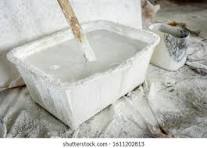Lime is the better choice of plasticizers Lime has been a staple in the construction industry for thousands of years. It’s a naturally occurring calcium carbonate that. When heated, transforms into quicklime or slaked lime depending on the process used. To make it workable, rock lime must be slaked in water, a process that generates immense heat. This hydration reaction turns the quicklime into a slurry, or slaked lime. Which is then mixed with water and sand to create mortar. When mixed with cement, slaked lime extends the mortar’s workability. Allowing it to be worked for a longer period before it begins to set. Lime also has the unique ability to seal cracks and remain flexible over time. This makes it an excellent choice for structures that need to withstand movement and settle naturally over the years.

Plasticisers
In the mid-20th century, plasticizers were introduced as a substitute for lime. These additives, often based on synthetic polymers. Designed to reduce the water content required for workability while still allowing the mortar to bond effectively with masonry units. However, these additives ultimately weakened the joints, leading to a reduction in the mortar’s compressive strength and durability. As a result, plasticizers were largely removed from the market. And lime is now being embraced once again for its superior properties and versatility in bricklaying.

Properties
Lime’s amazing properties and wide range of uses make it an invaluable material in the construction industry. From enhancing the workability of mortar to providing long-term crack resistance. Lime continues to prove its value after thousands of years of use. Its unique chemical and physical characteristics make it ideal for applications ranging from masonry to plastering. And its environmental friendliness adds to its appeal in modern sustainable construction practices. From enhancing the workability of mortar to providing long-term crack resistance. Lime continues to prove its value after thousands of years of use. Its versatility and performance make it a material of choice for both traditional and contemporary construction techniques.

Key advantages
One of the key advantages of lime is its ability to absorb and neutralize carbon dioxide as it cures, making it a more sustainable choice than many other building materials. This process, known as carbonation, reduces the mortar’s overall carbon footprint over time. Making it easy to maintain
Historic and cultural significance
Another important factor to consider is the historic and cultural significance of lime. As one of the earliest man-made materials, lime has played a crucial role in shaping our built environment for millennia. From the grand arches of ancient Rome to the intricate details of medieval architecture, lime has been at the heart of some of the most iconic structures in human history.
Despite its long history and proven track record, lime is often overlooked in modern construction. However, as we increasingly recognize the importance of sustainability and the need to preserve our built heritage, there is a growing appreciation for the benefits of this remarkable material.